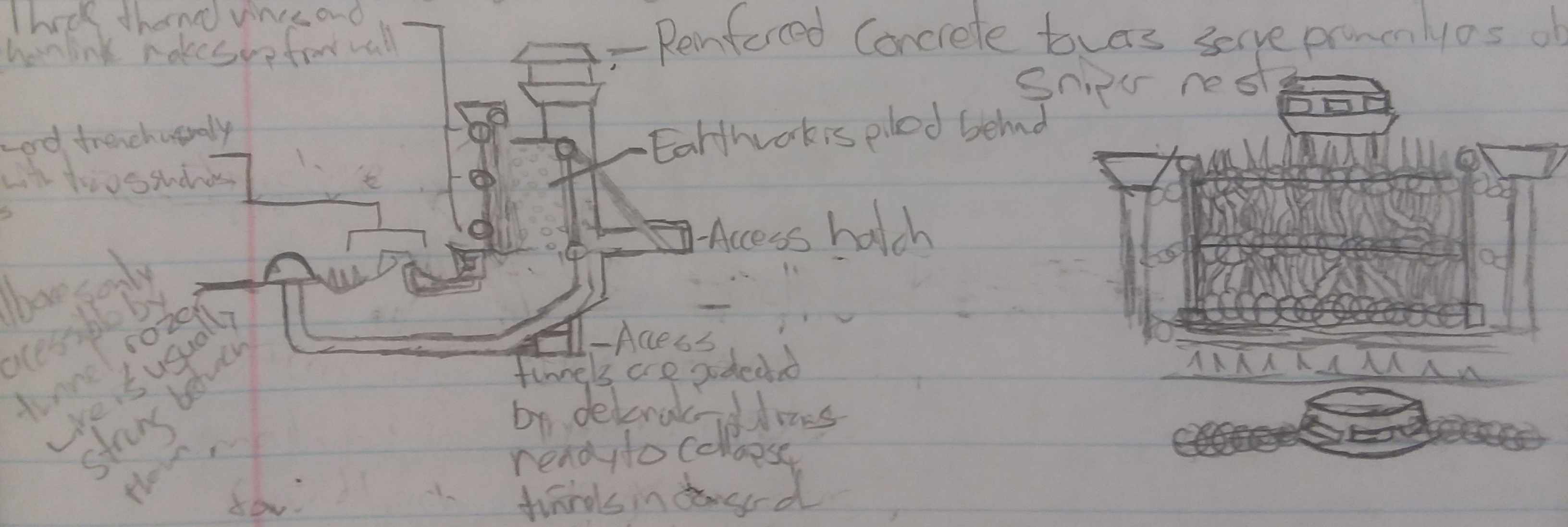Fort Horrendur Thornworks
The Thornworks is a defensive perimeter wall around the Fortress-Captial of Clan Ulvesbane, Fort Horrendur. It is a series of bunkers, pillboxes and watchtowers interwoven around an earthwork wall.
While the original Thornworks refers to the defensive wall around the vineyards of Fort Horrendur, Clan Ulvesbane has made it part of their standard defensive doctrine to replicate the Thornworks throughout their holdings and in cases of siege warfare.
Purpose / Function
The Thornworks is a defensive wall designed to be easily repaired and maintained, as well as provide the defenders with sustenance. The fortified earthworks creates a strong defensive line that is partially self sustaining, as the central bloodroot vines are an entanglement hazard that regrows when damaged. Bloodroot also produces edible berries that grow in its roots and tips, giving the defenders a source of food.
Alterations
As a defensive wall the Thornworks has taken a lot of damage over the centuries, however, no matter how much it's rebuilt and repaired it essentially stays the same. The power of the Thornworks is that it exists to be destroyed and remade. When a section of the Thornworks is destroyed by artillery or other siege equipment the earthworks is designed to spill out into the resulting breach. These thorn infested piles of dirt remain an obstacle for any assault force. Breaches in the wall may be repaired, retrofitted into bunkers or turned into gates. Due to this the Thornworks has developed into a patchwork of defenses, with some sections bristling with concrete reinforced strongpoints, while other sections are a jangled mess of wild bloodroot vines.
Architecture
The wall begins as a row of bloodroot vines grown on 9 ft vertical posts. A row of sandbags is piled in parallel to this wood and vine wall, approximately 5 feet inward. Dirt is piled between the posts and the sandbag wall, creating a solid earthwork barrier with an outer face of twisting, thorn-covered vines. Approximately 5 feet outward two lines of trenches are dug, separated by razor wire. The outer trench is filled with pikes that have been embedded into the bottom of the trench, forming a deadly pitfall trap. This outer trench is generally flooded with water from the surrounding brackish marsh. The inner trench is designed to be garrisoned by a defensive force, with the trench being reinforced with sandbags, concrete strongpoints, and hidden bunkers. Every 100 yards or so there are access tunnels between the trench and the inner section that run underneath the earthworks. These tunnels are designed to be collapsed if the enemy takes control of the trenches, with the interior trench wall dug to a 45 degree slope that prevents the trench from providing cover from defenders on top of the earthworks.
Approximately every 50 yards there are alternating concrete defensive structures. Watchtowers peak up over the earthwork from the inward section, allowing the defenders clear line of sight to the approach to the Fortress. While these primarily function as observation posts, they are manned with sharpshooters and machine gunners during defensive action. Additionally, a network of pillboxes runs along the outside of the Thornworks. These pillboxes are connected to the fortress' interior by underground tunnels, allowing their forward positions to be reinforced without the need for the defenders to expose themselves. A second and final line of razor wire is strung up between the pillboxes, forming the exterior perimeter.
History
In the time before Long Night the settlement that would come to be known as Fort Horrendur was once an agricultural research station dedicated to experimentation into genetically engineering plantlife that could survive in low-sunlight environments and extreme cold. One of their early successes came to be called the bloodroot, a thick, thorny, exposed-root plant that was bioengineered to have a proto-circulatory system to internally simulate the energy sunlight provides by recycling external heat in a fluid system. The root produced edible berries of a viscous of texture, both sour and bitter to the taste. The project was shelved at the time in favor of more consumer friendly alternatives, but a northern horticulture station remained open to maintain and observe the vines when left to fallow. When the Cataclysm came the polar regions were largely unaffected by the tectonic shifts, and so the research outpost became a Bloodroot Plantation to feed the isolated pocket of survivors that found their way to their shores. The Research Station was expanded in the early years of Long Night to include the gutted hulls of two tankers and a cruise ship, the resulting bunker-fort-city received its name from the half-heard curses of raiding parties that generally included the word "Horrendous." The local English dialect came to colloquially refer to the resulting structure as Horrendur, that horrendous fortress over yonder.
Type
Wall section
Parent Location
Owner
Ruling/Owning Rank
Owning Organization
Remove these ads. Join the Worldbuilders Guild










Comments